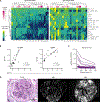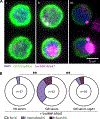Lupus IgA1 autoantibodies synergize with IgG to enhance plasmacytoid dendritic cell responses to RNA-containing immune complexes
- PMID: 38959329
- PMCID: PMC11418372
- DOI: 10.1126/scitranslmed.adl3848
Lupus IgA1 autoantibodies synergize with IgG to enhance plasmacytoid dendritic cell responses to RNA-containing immune complexes
Abstract
Autoantibodies to nuclear antigens are hallmarks of systemic lupus erythematosus (SLE) where they contribute to pathogenesis. However, there remains a gap in our knowledge regarding how different isotypes of autoantibodies contribute to this autoimmune disease, including the production of the critical type I interferon (IFN) cytokines by plasmacytoid dendritic cells (pDCs) in response to immune complexes (ICs). We focused on IgA, which is the second-most prevalent isotype in serum and, along with IgG, is deposited in glomeruli in individuals with lupus nephritis. We show that individuals with SLE have serum IgA autoantibodies against most nuclear antigens, correlating with IgG against the same antigen. We investigated whether IgA autoantibodies against a major SLE autoantigen, Smith ribonucleoprotein (Sm/RNP), played a role in IC activation of pDCs. We found that pDCs expressed the IgA-specific Fc receptor, FcαR, and IgA1 autoantibodies synergized with IgG in RNA-containing ICs to generate robust primary blood pDC IFN-α responses in vitro. pDC responses to these ICs required both FcαR and FcγRIIa, showing synergy between these Fc receptors. Sm/RNP IC binding to and internalization by pDCs were greater when ICs contained both IgA1 and IgG. Circulating pDCs from individuals with SLE had higher binding of IgA1-containing ICs and higher expression of FcαR than pDCs from healthy control individuals. Although pDC FcαR expression correlated with the blood IFN-stimulated gene signature in SLE, Toll-like receptor 7 agonists, but not IFN-α, up-regulated pDC FcαR expression in vitro. Together, we show a mechanism by which IgA1 autoantibodies contribute to SLE pathogenesis.
Conflict of interest statement
Figures







Update of
-
Lupus IgA1 autoantibodies synergize with IgG to enhance pDC responses to RNA-containing immune complexes.bioRxiv [Preprint]. 2024 Apr 4:2023.09.07.556743. doi: 10.1101/2023.09.07.556743. bioRxiv. 2024. Update in: Sci Transl Med. 2024 Jul 3;16(754):eadl3848. doi: 10.1126/scitranslmed.adl3848. PMID: 37745328 Free PMC article. Updated. Preprint.
References
-
- Båve U, Magnusson M, Eloranta M-L, Perers A, Alm GV, Rönnblom L, FcγRIIa Is Expressed on Natural IFN-α-Producing Cells (Plasmacytoid Dendritic Cells) and Is Required for the IFN-α Production Induced by Apoptotic Cells Combined with Lupus IgG. J. Immunol 171, 3296–3302 (2003). - PubMed
Publication types
MeSH terms
Substances
Grants and funding
LinkOut - more resources
Full Text Sources
Medical
Miscellaneous

